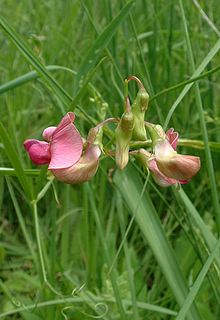| Lathyrus sylvestris | |
|---|---|

| |
| Conservation status | |
 Least Concern (IUCN 3.1) | |
| Scientific classification | |
| Kingdom: | Plantae |
| Clade: | Tracheophytes |
| Clade: | Angiosperms |
| Clade: | Eudicots |
| Clade: | Rosids |
| Order: | Fabales |
| Family: | Fabaceae |
| Subfamily: | Faboideae |
| Genus: | Lathyrus |
| Species: | L. sylvestris |
| Binomial name | |
| Lathyrus sylvestris L. | |
| Synonyms | |
List
| |
Lathyrus sylvestris, the flat pea or narrow-leaved everlasting-pea, is a species of flowering plant in the pea and bean family Fabaceae. It is native to parts of Africa, Europe, and Asia.
The narrow-leaved everlasting-pea forms a mat of herbage. The stems are winged. Each leaf is made up of two elongated leaflets. The flowers are pink. The fruit is a legume pod about 2 inches (5 cm) long.
Description

The narrow-leaved everlasting-pea is a perennial plant which can grow 200 cm (79 in) by climbing with its tendrils. Without any support it can reach about 75 cm (30 in) tall. The stem is floppy and flat with wide wings. The leaves are alternate with short winged stalks and stipules. The leaf blades are pinnate with a single pair of narrow lanceolate leaflets with entire margins and three tendrils. The inflorescence has a long stem and three to ten pinkish-red flowers. These have five sepals and five petals and are irregular. The uppermost petal is known as the "standard", the lateral two as the "wings" and the lowest two are joined to form the "keel". There are ten stamens and a single carpel. The fruit is a long pod containing five to fifteen seeds.
Distribution and habitat
The narrow-leaved everlasting-pea is native to parts of Africa, Europe and Asia. Its natural habitat is forest edges, sparse broad-leaved hillside forests, dry hillside meadows, hedgerows, embankments and waste ground. It uses its tendrils to scramble over plants, shrubs and the lower branches of trees.
Uses
This plant is sometimes used to control erosion and for this purpose it is generally planted along with a grass species. It can do well in highly disturbed habitat. There is a cultivar called 'Lathco'.
References
- Rowe, J., Shehadeh, A. & Maxted, N. (2019). "Lathyrus sylvestris". IUCN Red List of Threatened Species. 2019: e.T176568A19405519. doi:10.2305/IUCN.UK.2019-2.RLTS.T176568A19405519.en. Retrieved 17 January 2024.
{{cite journal}}: CS1 maint: multiple names: authors list (link) - "Lathyrus sylvestris L." Plants of the World Online. Royal Botanic Gardens, Kew. Retrieved 5 July 2024.
- BSBI List 2007 (xls). Botanical Society of Britain and Ireland. Archived from the original (xls) on 2015-06-26. Retrieved 2014-10-17.
- ^ "Lathyrus sylvestris". Germplasm Resources Information Network. Agricultural Research Service, United States Department of Agriculture. Retrieved 14 January 2018.
- ^ Lathyrus sylvestris. USDA NRCS Plant Fact Sheet.
- ^ "Narrow-leaved Everlasting Pea: Lathyrus sylvestris". NatureGate. Retrieved 2013-12-30.
External links
 Media related to Lathyrus sylvestris at Wikimedia Commons
Media related to Lathyrus sylvestris at Wikimedia Commons
| Taxon identifiers | |
|---|---|
| Lathyrus sylvestris |
|
This Fabeae-related article is a stub. You can help Misplaced Pages by expanding it. |